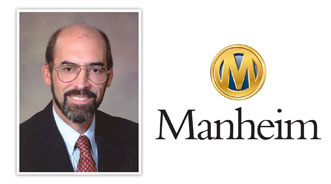3 Reasons Not to Expect Significant Wholesale Price Softening in Second Half of Year

Along with discussing the latest Manheim Used Vehicle Value Index, economist Tom Webb highlighted why he doesn’t expect a significant drop-off in wholesale prices during the second half of the year.
Webb indicated the No. 1 reason why he has “made comments that I think the easing might be a little less than people are expecting” is because of increased volume. The National Auto Auction Association recently reported that May’s volume jumped 10 percent year-over-year. And the update prepared during the middle of last month showed that year-to-date volume was 3 percent higher.
Webb told conference call participants on Monday that “the numbers so far are confirming” his projection about wholesale prices.
“The influx of units is not outsized relative to retail demand as opposed to past cycles,” he continued.
As Auto Remarketing reported, June’s used-vehicle sales total surpassed what CNW Research projected. And the second quarter included the second- and third-highest monthly sales totals ever in the certified pre-owned market, according to Autodata Corp. As a result, the CPO market generated its highest quarterly sales figure in history.
With those trends in place, Webb explained what would have to happen in order for dealers to see significant drops in wholesale prices.
“I think you would have to have some significant deterioration in retail demand,” Webb said. “The dealers aren’t going to buy the vehicles if they can’t sell them for a profit. The only scenario I can see that occurring is if retail financing were to change. Again, I think that’s very unlikely in the near term.”
Yet another reason why wholesale prices are staying strong is how the new-vehicle market is behaving. Again, Webb indicated why during his quarterly conference call.
“The new-vehicle market as we’ve seen continues to garner strong transaction pricing,” he said. “Incentive activity has remained restrained and inventory levels are in check. There’s no indication that I see that those factors are going to change.”
More Evidence of Active Retail Market
Webb also pointed out that strength in the retail market is evidenced by the same-store used vehicle unit volumes for the seven publicly traded vehicle dealership groups, which have seen year-over-year growth for the past 16 consecutive quarters.
The Manheim economist also added that employment growth is a major factor driving sales as consumers have greater need for personal transportation and have the means to pay for it.
Manheim also mentioned several other emerging trends in the used-vehicle market based on the first-half results of this year, including:
—Pickup trucks continued to outperform all other used-vehicle segments during the first half of 2013. Wholesale prices increased 3.6 percent year-over-year due to increased demand from the improvement in the housing industry, combined with limited supplies in the wholesale market, especially for units with less than 100,000 miles.
—Midsize and compact cars experienced the largest drop in prices year-over-year at 4.0 percent and 5.4 percent, respectively, due to the attractive offerings, pricing and financing options available on midsize and compact cars in the new-vehicle market. This hurt the overall resale performance of some commercial fleet managers whose primary price range is $11,000 to $13,000, but many makes and models popular with commercial fleets continued to perform very well in the auction market.
—Rental risk prices were strong in June. Prices for rental risk units sold at auction, unadjusted for market class and mileage, increased 4.8 percent in June compared to a year ago, though volumes were down for the month. Rental risk prices in June were basically unchanged from both May and a year ago, after adjusting for broad shifts in market classes and mileage.
Wholesale Prices Increase in June
After declining in each of the first five months of the year, Webb indicated wholesale used vehicle prices (on a mix-, mileage-, and seasonally adjusted basis) rose in June.
The movement brought the Manheim Used Vehicle Value Index to a level of 119.7, which was 3 percent lower than a year ago.
On a quarterly basis, wholesale prices declined 0.8 percent in the first quarter of 2013 and 2.1 percent in second quarter.
The pattern of wholesale pricing during the first half of 2013 was influenced by the delayed, and light, tax refund season and by ‘payback’ for price hikes in late 2012 resulting from Hurricane Sandy,” Webb said.
“Nevertheless, total market activity was consistent with earlier expectations and helped bring wholesale prices in better alignment with retail new and used vehicle prices,” he continued.
“Continued healthy used-vehicle sales and profits should enable wholesale prices to show only a modest easing in the face of higher supplies in the back half of 2013,” he went on to say.
As mentioned previously, activity related to pickups sparked the index to edge higher. Manheim indicated prices for pickups rose 3.6 percent year-over-year in June.
Meanwhile, the other five vehicle segments that Manheim tracks slipped anywhere from 1.8 to 5.4 percent in June. The year-over-year price declines came in as follows:
—Compact cars: down 5.4 percent
—Midsize cars: down 4.0 percent
—Luxury cars: down 3.6 percent
—CUVs and SUVs: down 1.8 percent
—Vans: down 2.2 percent
Nick Zulovich can be reached at nzulovich@autoremarketing.com. Continue the conversation with Auto Remarketing on both LinkedIn and Twitter.


